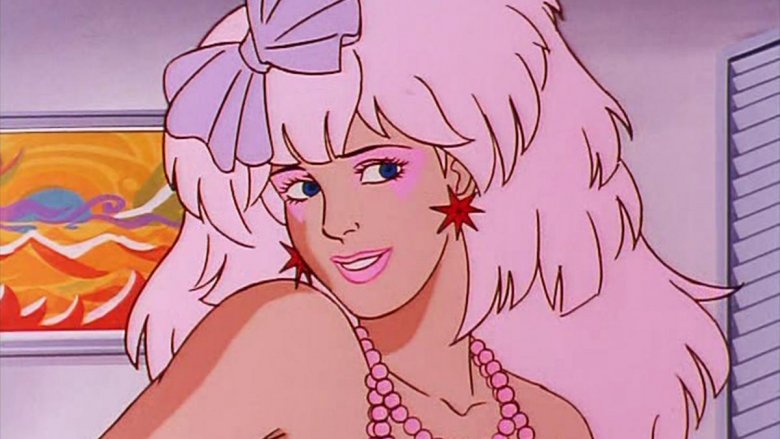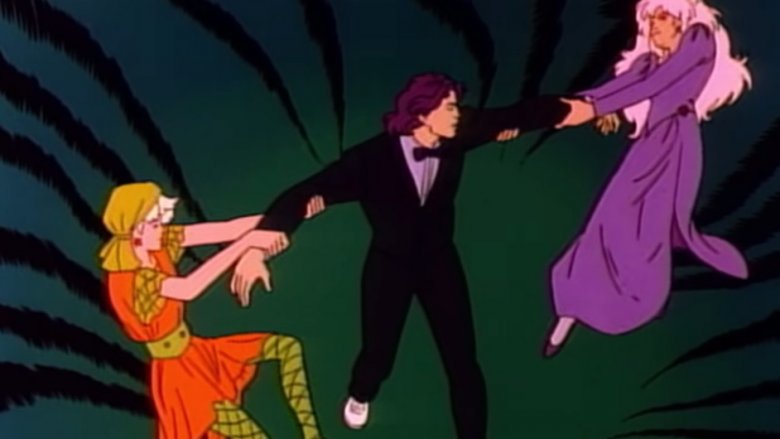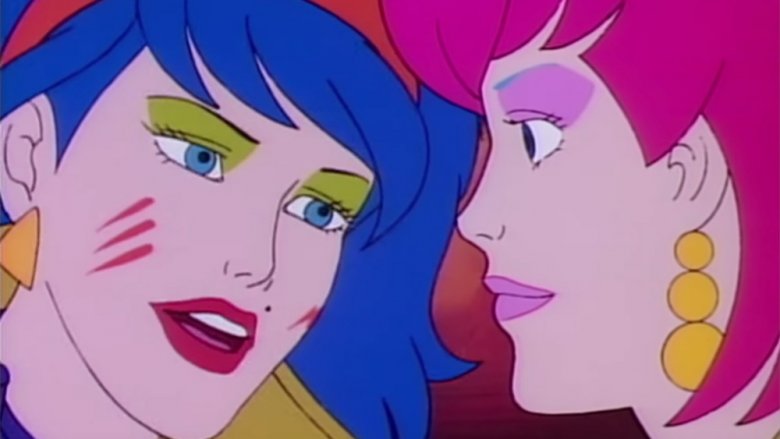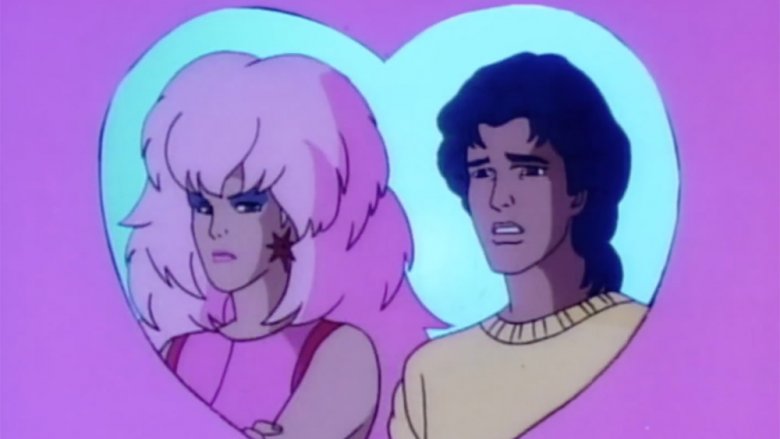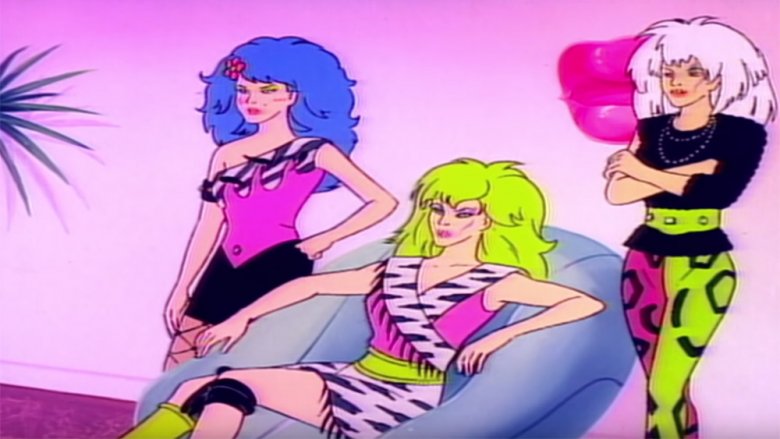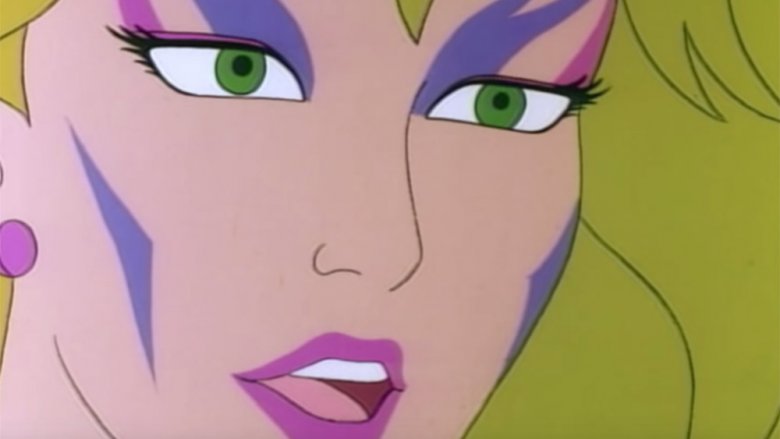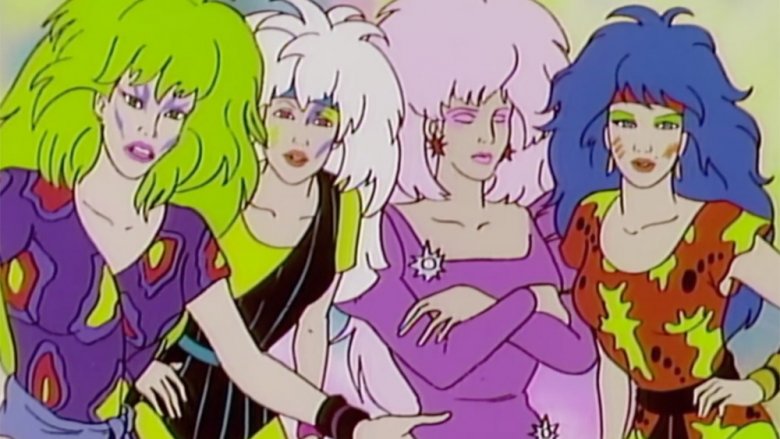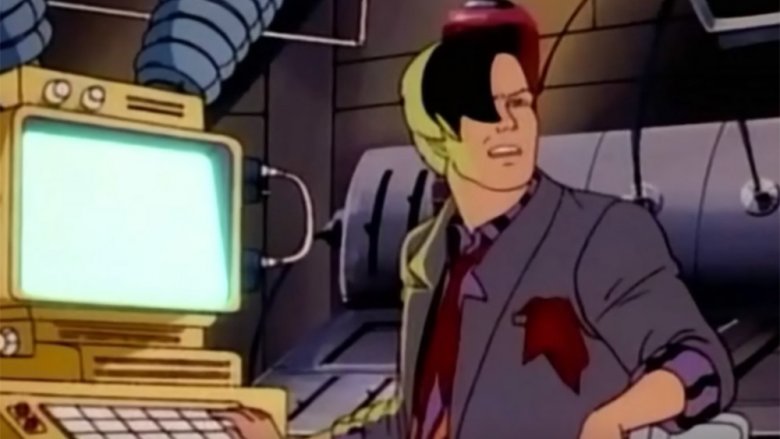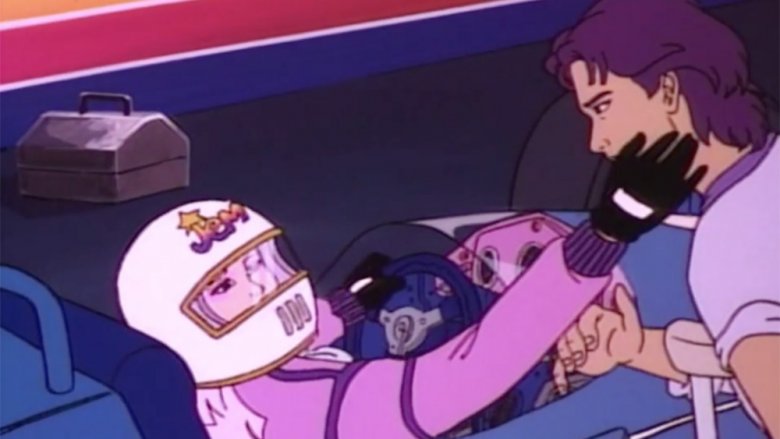Things Only Adults Notice In Jem
Jem is excitement! Jem is adventure! Jem is unbelievably bizarre when you look back on it as an adult!
Of course, everyone's favorite '80s toy commercial cartoon about the world of glamour, glitter, fashion, and fame was never all that normal to begin with. It is, after all, the story of a record executive who finds a sentient computer that may or may not be a digital recreation of her dead mother and uses it to achieve success as a glam rock superstar with a secret identity, a premise that asks you to accept a whole lot even before the show begins. When you watched it as a kid, though, all of that made sense — or at least as much sense as any other cartoon did. When you go back to it as an adult, though, you might notice that there are things that go well beyond just the Holograms' unique approach to music that are more than a little bizarre. Here's the stuff about Jem that you only really notice as an adult.
The unnecessary identity
The biggest source of drama on Jem, other than all those times when the Misfits try to murder the Holograms with laser beams or active volcanos, is Jerrica Benton's secret identity. See, she has to keep everyone from knowing that she's Jem, or else... something... bad will happen? There are probably going to be consequences, right? We just never actually learn what they are, or why they would happen.
For its entire 60-episode run, the show never actually explains why Jerrica is compelled to complicate her life by maintaining a secret that has no reason to be a secret in the first place. The existence of Synergy and her infallibly realistic holograms might cause some headaches, but the fact that Jerrica is performing under a stage name is not really a big deal. Nobody here in the real world was scandalized to find out that, for instance, Lady Gaga was actually named Stefani, so it stands to reason that the worst thing that could happen to Jerrica if her identity was revealed would be like when we were all just a little weirded out by Garth Brooks pretending to be an emo rock star named Chris Gaines. In fact, considering that Jerrica is also a record executive who funnels Jem's earnings into a dubious charity that she runs with her sister, revealing her identity might actually make things seem less shady.
The 2015 comic book reboot of Jem actually did justify the whole secret identity setup. Jerrica was redesigned as an intensely shy character who used the literally larger than life identity she was given through Synergy's holograms to overcome her stage fright. Even better, her anxiety and awkwardness made her conversations with Rio — recast as a music journalist rather than just an overblown roadie — come off as secretive and aloof, adding to her mystery. On the show, though, the only real consequence for revealing her double identity is that Rio — who occasionally announces that he hates liars and despises deception while angrily kicking over a potted plant — might be a little mad about it. Really, though, if the worst thing that happens is that you break up with Rio Pacheco, who sucks pretty bad, then you're actually in pretty good shape.
Kimber + Stormer 4 Ever
"The Bands Break Up," the episode in which Kimber of the Holograms and Stormer from the Misfits ditch their respective ensembles to cut an album as a duet, is often considered to be loaded up with the kind of lesbian subtext that goes over your head when you watch it as a child. Really though, that's just not true — not because it's not there, but because that implies a subtlety that only adults would notice. The fact is, there's nothing sub about about it. It's just straight-up text.
Maybe it's because Kimber is usually featured in plots when she bounces from one love interest to the next, making Stormer seem like a pretty obvious next target for her usual 22-minute round of flirting. Maybe it's the idea that Stormer herself is portrayed as the sweeter member of the Misfits, who's clearly craving a love and affection that she's not getting from her other relationships but finds with her rival. Maybe it's the way that their intense sniping at each other during an open-mic night eventually leads to them proclaiming an affection that pits them "against the world" in a way that even the most dedicated fan-fiction writer would think was a little too on the nose for an enemies-to-lovers story. Maybe — and let's be real here, this is probably the answer — the writers and performers on this episode knew exactly what they were doing. Either way, it's pretty clear as a grown-up that those two are girlfriends now, even if you believed that they were just gal-pals when you saw it in the '80s.
It's such an undeniable element of the show that, like Jerrica's secret identity troubles, Kimber and Stormer's romantic relationship was something that Kelly Thompson and Sophie Campbell made completely canon in the comic book. Well, more canon, anyway. There's no real way to watch the original episode and think that it wasn't meant to be that way from the start.
Rio + Jerrica 4 Never
Let's face it, friends: Rio sucks. He's a hanger-on whose job with the band is vague enough that it's almost impossible to figure out why he's even there, and he's intensely jealous when it comes to his relationship, even though he is himself two-timing Jerrica with the glamorous Jem, who he believes is a completely different person. And that's before you get to the part where he can't tell that Jem actually is Jerrica, even though they have the same speaking voice, don't actually look that different, and hang out with the same people but never each other.
Here's the thing, though: as far as that relationship is concerned, Jerrica also sucks. She keeps up the charade, even knowing how much Rio hates being lied to, because it's easier on her than telling the truth. Worse, she occasionally plays her two personalities against each other while bemoaning the idea that Rio doesn't actually love her for who she is, which she is actively hiding. She even winds up making a third identity named Jaime in the show's final season, after she and Rio get into a huge fight and he dumps Jerrica in favor of Jem. Oh, and then Rio and Jaime meet up and start dating, because who says you can't build a love rhombus with only two people?
Seriously: they are terrible. But hey, at least they're both equally terrible!
The Misfits don't have black friends
Something you might've noticed when you were watching Jem as a kid was that the Holograms have exactly the kind of diverse lineup that you'd expect from a show that, by 1985 standards, was meant to be progressive. Jerrica and Kimber are white, but Aja's Chinese-American, Shana's black, and Raya, who joins the cast in the second season, is Latina. And that's just the band. If you throw in the troublesome orphans that they're always taking care of, you've got some pretty solid representation on the heroic side of things.
The villains, however, are... well, there's no easy way to say it. The Misfits are all white. It's never something that comes up explicitly, and most of Pizzazz's considerable ire is reserved for Jem herself, but when you look at the two bands next to each other as an adult, it's one of those things that you just can't stop noticing. Plus, the fact that they don't really have any good reasons to be so furious at the Holograms makes the whole thing seem like it's just not a great look.
There's actually a real-life reason behind this one, though, and believe it or not, it's the same reason that Cobra can occasionally come off as a white supremacist organization on the old G.I. Joe cartoon. Back in the day, Hasbro apparently had a policy forbidding any characters of color from being portrayed as villains. It's easy to argue that while this was probably an attempt to sell as many dolls and action figures as they could to as many different kids of kids who would buy them, there was also at least some good-hearted attempt in there to get away from harmful stereotypes that were so prevalent in media. Of course, that didn't stop them from throwing in a Middle Eastern country named "Carbombya" over on Transformers, which was fortunately never a stop on the Holograms' world tour. Either way, Jem creator Christy Marx had originally intended Jetta, the saxophonist who joins up with the Misfits in season 2, to be black to add even more diversity to the cast, but was shot down by the higher-ups. The result? Jetta was redesigned to be white, and the Misfits continued to be just a little too uncomfortable for a glam rock rivalry.
Poor Little Rich Girl
From Mumm-Ra the Ever-Living to Skeletor and all the way down to the forces of Cobra — a ruthless terrorist organization determined to rule the world — cartoons in the '80s had no shortage of fearsome villains. Even the worst of them, however, would probably get at least a little uncomfortable around Phyllis Gabor, better known to her glam-rock devotees as Pizzazz, leader of the Misfits. After all, she's basically a full-on sociopath, who proves herself to be immune to one of Synergy's illusions at one point by declaring that she literally does not have a conscience. More on that in a moment.
Really, though, behind all the attempted volcano murders and that time she flew around Los Angeles trying to destroy everything Jem loved with a laser gun mounted on the front of a hang glider — a moment that we sadly never got a playset of — Pizzazz actually has a pretty tragic story. For all punk aesthetics and pretentious of gritty realness, Pizzazz grew up rich, but had plenty of tragedy to go along with her family's seemingly endless wealth. Her mother left when she was a kid, and her father, Harvey, is consistently portrayed as being completely uninterested in his daughter. He ignores her in favor of his vague business concerns, relying on his money to maintain their relationship, leading her to become the shrieking, spoiled character we know today. That makes her a uniquely tragic figure in the show — Jerrica and Kimber's mom and dad might've died, but at least they have plenty of evidence that their parents loved them. Pizzazz has a living reminder of how little her father cares for her every time she goes home.
Considering that this is where Pizzazz is at mentally, it's no wonder that she hits a true breaking point when Jerrica Benton rolls into Starlight Records, refers to her music — the one form of self-expression she has, which has allowed her to get the attention and love that she was denied as a child — as "trash," and kicks her off the label. Glider-mounted laser attacks are very rarely a real solution to a problem, but it's pretty easy for adults to notice why she'd turn to that level of sci-fi-vi (science fiction violence) when a woman who had everything showed up and casually destroyed her world.
Their songs actually are better
While you might grow attached to the villains as you get older, the kids in the audience of a show like Jem are conditioned from the very first moments to side with the good gals. We're meant to believe that the Holograms' success in the world of music is completely earned, that it was their talent and hard work that propelled them to fame, and not just narrative convenience. When the Misfits show up in the opening titles to sing "we are the Misfits, our songs are better," we're supposed to see that as pure, simple jealousy.
Go back and give the Jem soundtrack a listen as an adult, though, and it's hard not to notice that the Misfits' songs actually are better — and not just because they had the songwriting chops to rhyme "songs are better" with "gonna get 'er." With all due respect to Jem (and her singing voice actress, Britta Phillips), the Holograms tend to offer up songs that are at best pretty generic, and frequently just flat-out bad. The major exceptions are the show's two theme songs, which are basically just Jem singing about how great she is in the glam rock equivalent of a rap battle, which rules. The rest of the catalog, though? "We Can Make a Difference" dissolves into full-on caterwauling by the end, and "Takin' a Train," a song about takin' a train, should be outlawed under the Geneva Convention.
For a contrast, take a listen to the Misfits' signature songs. "Makin' Mischief," which has an extremely dope bass line that's often used for background music, and "Winning Is Everything" are undeniable bangers, and the rest of the songs are almost always enjoyable. The only real exception is "Misfits In Hawaii," a song that the Misfits wrote while they were in Hawaii, about the Misfits being in Hawaii. It's not great in the traditional sense, but rhyming "we wear a sarong" with "it looks so wrong" definitely pushes it into the so bad it's good category.
Heroes and (super)villains
The closest we get to a good reason why Jem has to keep a secret identity is that Synergy, a sentient computer program that can project absolutely convincing holograms, could potentially be used for evil if she was discovered by bad guys like Eric Raymond. Sure, Synergy could also probably do way more good than just providing dazzling light shows and the occasional distraction bear, but in a world where glam rock is literally the most important thing that exists in this universe, that can be forgiven.
Either way, this implies that Synergy is utterly unique, and that revealing her existence would represent a huge shift in the way her world worked, which is all well and good until you remember the Hasbro Expanded Universe. While there's never the crossover that you really want, a handful of connections show us Jem, G.I. Joe, and Transformers — and Inhumanoids, the one where Cthulhu monsters claw their way up from subterranean depths and try to have sex with the Statue of Liberty — all take place in the same world. If that's true, then Synergy, while definitely pretty notable, isn't quite the world-shattering singularity that she would be in a world that didn't have, say, a machine that can vaporize all the money in the world.
Even if you just look at Jem itself, though, there are hints that the world is a little more off-kilter than you might expect, like, say, the fact that full-on Batman-style supervillain arch-criminals exist. In season 2's "The Presidential Dilemma," Washington DC is terrorized by a costumed criminal — complete with a domino mask — named the Washington Marauder, who has been pilfering national treasures and keeping them in an honest-to-Synergy underground lair. If this world is verging on DC Comics-level super-crime, then sentient holograms probably wouldn't be that big a deal. Especially considering...
Techrat has a time machine
Techrat has a time machine.
No, really, Techrat has a time machine. That's actually a pretty standard-issue plot device for a lot of adventure cartoons in the '80s — G.I. Joe went back to ancient Greece to hang out with the Argonauts and DuckTales lived up to its theme song by hitting up the Middle Ages — and as a kid, you probably just accepted that time machines were going to be a fact of life once you grew up and formed a band, met a car that was also a robot, went to live with the World's Richest Duck, or whatever fate had in store. As an adult, though, it's impossible not to notice the fact that a weirdo like Techrat has literally invented a time machine in his basement and then elected to use it solely for glam rock purposes. It's weird on every conceivable level.
The weirdest part? Techrat's time machine seems to be able to calculate the relative value of human and animal life. Jem's "Journey Through Time" finds the Holograms being sent back to the 18th century, World War II, and Woodstock, with the catch being that some kind of equivalent needs to be brought to the present. So, what's the equivalent of five glam rockers? Apparently, one French noblewoman equals two army soldiers equals four hippies equals one baby dinosaur. We're never really told what Techrat's qualifications are, but that's an actuarial table that'll keep us all up at night.
Intrigue at the Indy 500
Despite featuring episodes about time travel, supervillains, and the mystical city of Shangri-La, the weirdest installment of Jem's 60-episode run is the one that features a relatively realistic plot. The word that's doing the heavy lifting there is "relatively," but "Intrigue at the Indy 500" is set at a famous real-world event, and features an almost distressingly real consequence for Eric Raymond, who is in danger of having his legs broken after his gambling gets him in debt to the mob. There's even a scene when Synergy's holograms are used in a surprisingly practical way, providing an intangible 3D blueprint for the band to rebuild a race car after it's torn apart.
The events that drive the plot — so to speak — are even technically possible, although they're so far on the edge of what could actually happen in the real world that when you look back as an adult, they seem even stranger by comparison. The short version is that Jem, a world-famous rock star, has to compete in the Indy 500, a massively well-known sporting event. While she's racing, Pizzazz, who is also a world-famous rock star, jumps over the fence, runs into the infield, hijacks another racer's car, and starts racing herself. Pizzazz takes the lead, but she's so reckless that she causes most of the other racers to crash. The two musicians then come in first and second, with Jem sliding across the finish line and into the win after her car loses a wheel and careens into a fiery crash, with Jem herself being dragged from the wreckage unconscious as the car explodes.
Got it? Great. Now go back and replace "Jem" in that summary with "Beyoncé Knowles," and "Pizzazz" with "Taylor Swift," and imagine this happening in the real world. "Beyoncé Wins Indy 500, Narrowly Escapes Exploding Car After Attack By Taylor Swift" is the kind of headline that would make the moon landing look like page three material at best. And yet, one this episode is wrapped up, it's never mentioned again. You'd think it would come up at least as often as, say, the importance of literacy, but no. It's just another day in the endless battle for glam rock supremacy.
